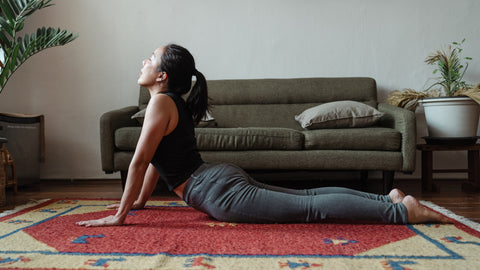So there you are sitting in your car in the parking lot of your local health food grocery and there they come:the fit people. Girls with their sun-streaked hair pulled smartly in a bun, walking with their weirdly good posture in their workout gear. The men with their muscles rippling under their wife beaters and their fit bits on their arms.
You look down on your less than perfect physique and think, “I’ll never be one of them.” But the truth is, there is nothing inherently different about you and any one of those people. The truth is – you have the potential to possess your dream body. The only thing separating you from these people is a little motivation.

How to Motivate Yourself to Exercise Regularly | 6 Simple Steps
In order to motivate yourself to exercise, you need to:
(1) Get very clear on what your goals are
(2) Determine the proper exercise regimen
(3) Use positive reinforcement by rewarding yourself
(4) Create a system of accountability
(5) Be realistic about your goals and
(6) Find the right time to act on your fitness goals.
Step One: Understanding Your Why
First off, you need to think about why you want to exercise in the first place because unless you answer the WHY question with some sincerity, it’ll be difficult to ever find motivation to work out.
Is it so that you can lose weight? Are you trying to build muscle? Do you want to feel more confident and comfortable in your own skin? To be more attractive?
You need to be honest with yourself in answering the question, because your answer serves as the emotional fuel that will provide you with necessary motivation.
Secondly, you need to answer the question of what are you doing with your time when you’re not exercising** – specifically when you have the time to do it.
Do you waste time watching T.V.? Are you mindlessly browsing social media outlets, randomly browsing the internet, or smoking weed with friends?
By answering the question, you see first-hand how the activities we usually engage in rather than doing things we know are good for us really aren’t worth it.
As humans, what sets us apart from other animals is our desire to be great as opposed to simply survive. We all have a vision of what our ideal life might look like. The desire to change your life through exercising in itself is evidence that there is some way you think you can improve your quality of life.
Answering questions related to the reason you want to alter your habits are really important to whether or not you’ll succeed in changing. The reason being that when we forget (and we forget quite often) the reason we’re struggling to improve our lives, we tend to retreat to our habitual selves; to the person we were before we made the decision to change.
Having a clear understanding of your ‘why’ (what you want to change and why you want to change it) is what pulls you through the tough times you will inevitably face when altering your habits.
Step Two: The Proper Exercise Routine
It’s really important to figure out how to exercise (depending on your goals) because one of the reasons we don’t exercise in the first place is we don’t know what we’re doing and we’re scared of what people will think of us.
Do your research, and don’t be afraid. Everybody is worried about themselves, nobody cares about how YOU look!
Depending on your goals (that you come up with when answering the ‘why’ question), you should be doing different exercise routines.
If you want to generally be healthier, your options are unlimited. You can hike/walk/run a few times a week and it’ll get the job done.
If you want to pack on muscle and get to a point where every muscle on your body is defined, you need to be doing a lot more work and dieting properly. You would need to determine a weight-lifting regimen based on research.
If your goal is to lose weight, you can do interval training aimed at burning fat quickly.

Step Three: Make use of positive reinforcement
If you exercise, you know you will eventually see the positive changes you want to in your body and in your life, but most people are too results oriented. We get discouraged if we don’t see a reward right away. So what we propose is to give yourself one.
Author Charles Duhigg, author of The Power of Habit: Why We do What We Do In Life and Business, says that to successfully add a new habit, we need to create a neurological “Habit Loop” in which we begin to associate certain events with rewards.
In other words, say you treat yourself to a massage or dessert every time you exercise. Eventually, exercise will become worthwhile to you because you have something immediate to gain every time you do it. Hence, exercise becomes an event you enjoy rather than a time of suffering.
The idea is that once you consistently make the time to exercise with the help of a reward that you give yourself, you will start to see the inherent benefits that exercise brings. Pretty quickly, exercise itself will be the reward.
Step Four: Create accountability
Even though we may wish we didn’t, we care a lot about what people think of us. Fortunately, when it comes to exercising, we can use that to our advantage.
There’s a ton of research out there to support the notion that we are way more likely to keep promises when we make them in the presence of friends or other people we think have a positive image of us.
It creates a sense of ownership to our own goals. We don’t want to distort the positive image we know that other people have of us by making it seem like we can’t keep our word to ourselves.
Jeremy Goldhaber-Fiebert,PhD, and assistant professor of medicine at Stanford University suggests that it might even be a good idea to make pacts with friends in which you agree to pay a monetary penalty to them if your skip your routine. He’s so adamant about the concept that he uses it to motivate himself.
He’s been quoted saying,
“If I don’t do that (exercise), I’m going to have to pay some kind of penalty, whether it’s monetary or the embarrassment of having friends know I didn’t live up to my word.”
Step Five: Be realistic
If you set your goals too high, you may never reach them. Don’t tell yourself that if you don’t look like The Rock within two months you’re a failure. In speaking about people who regularly work out, expert Roger Lawson says,
“They’re simply too hard and expect too much from themselves; they think it has to be much harder than it has to be and when they don’t live up to the expectations that set for themselves, it all begins to fall apart.”
Take small steps. Doing something is better than doing nothing. Start with something you can do effortlessly. Instead off setting out to exercise 5-6 times a week, aim to do it 1-2 times consistently. Set the bar low so that you stay strong mentally and don’t get discouraged. The goal is small victories and consistency. I promise you’ll know when to step it up as you go.
Step Six: Implement other healthy lifestyle habits that will motivate you to go to the gym
When you start living a healthier lifestyle in general, you’ll exercise more. By the same token, when you start exercising more often, you’ll start eating healthier, sleeping earlier, waking up earlier.
All positive health habits build on each other, so whatever you can do in other areas of your life to contribute to your health will help motivate you on a daily basis.
When is the right time to exercise?
It isn’t really important what time of the day you act on your fitness goals, but it is important to try and exercise at the same time every day. Because the thing is, motivation is unreliable after some time.
Motivation gets you started, but what keeps you going is making a habit out of going to the gym regularly. One of the best ways to do this is by going to the gym at the same time every day (or on days that you go). When you go at the same time
One of the best ways to do this is by going to the gym at the same time every day (or on days that you go). When you go at the same time every day your body is prepared at that time for exercise and your mind will signal to you that it is time to workout!
Action steps to take now
- Write down the exact reasons you want to exercise based on the questions above – spend the time to be honest with yourself.
- Based on the reasons you want to exercise, do some research to find the best regimen to help you push toward your goals.
- Decide how you can positively reinforce your own actions.
- Tell the people you care about what your goals are.
- Choose 1-2 other SMALL healthy lifestyle changes you can make and start acting on them immediately.
- Decide how many times a week you want to exercise, and what time during the day. Stick to your plan.
Concluding Remarks:
Exercising regularly isn’t easy. It’s a big commitment and it requires serious time and energy. But if you keep your mind focused on the outcome, you can make it happen. Follow the steps outlined above and we promise you are well on your way to your fitness goals.
